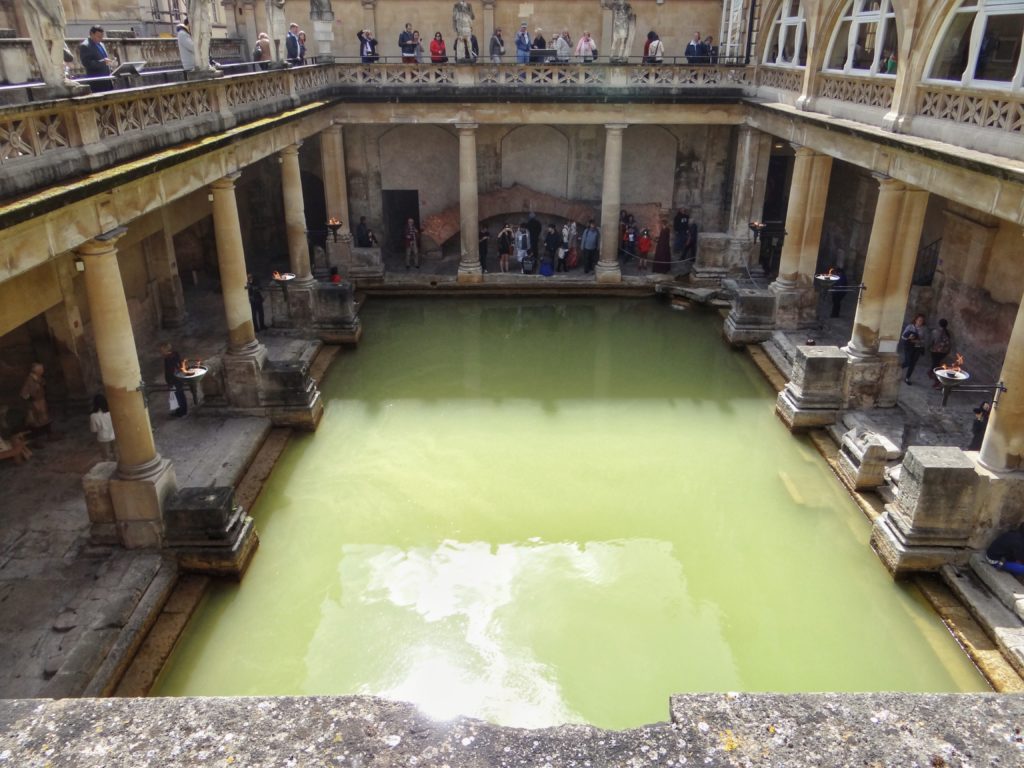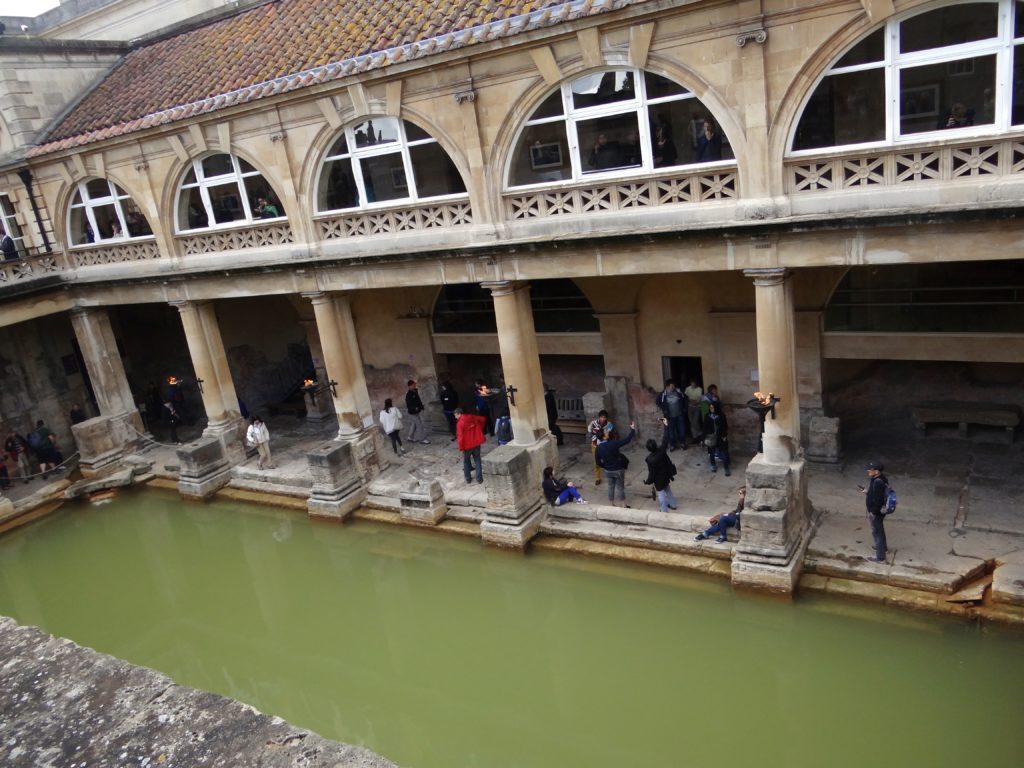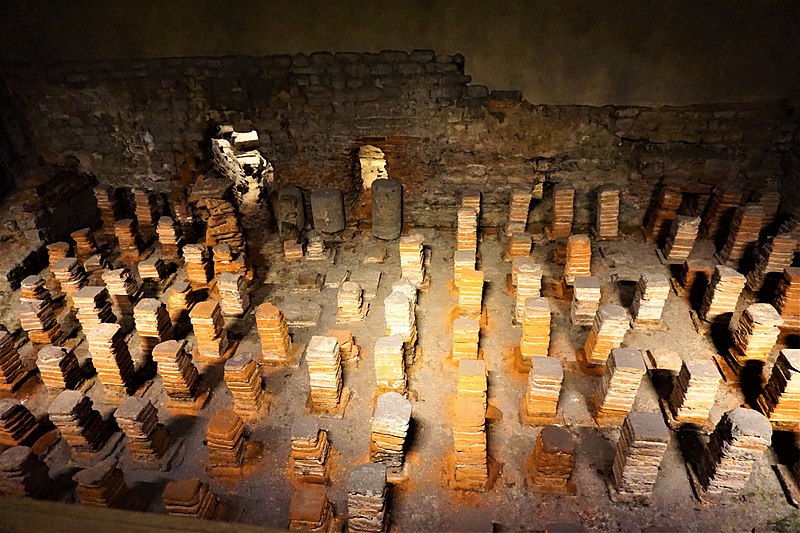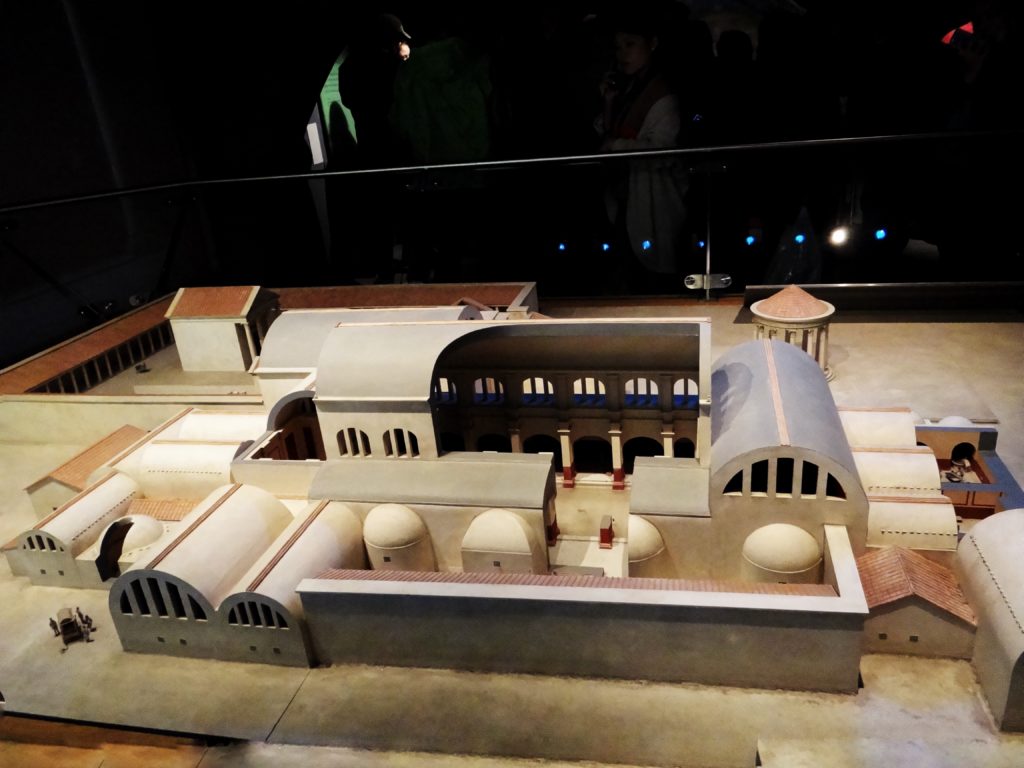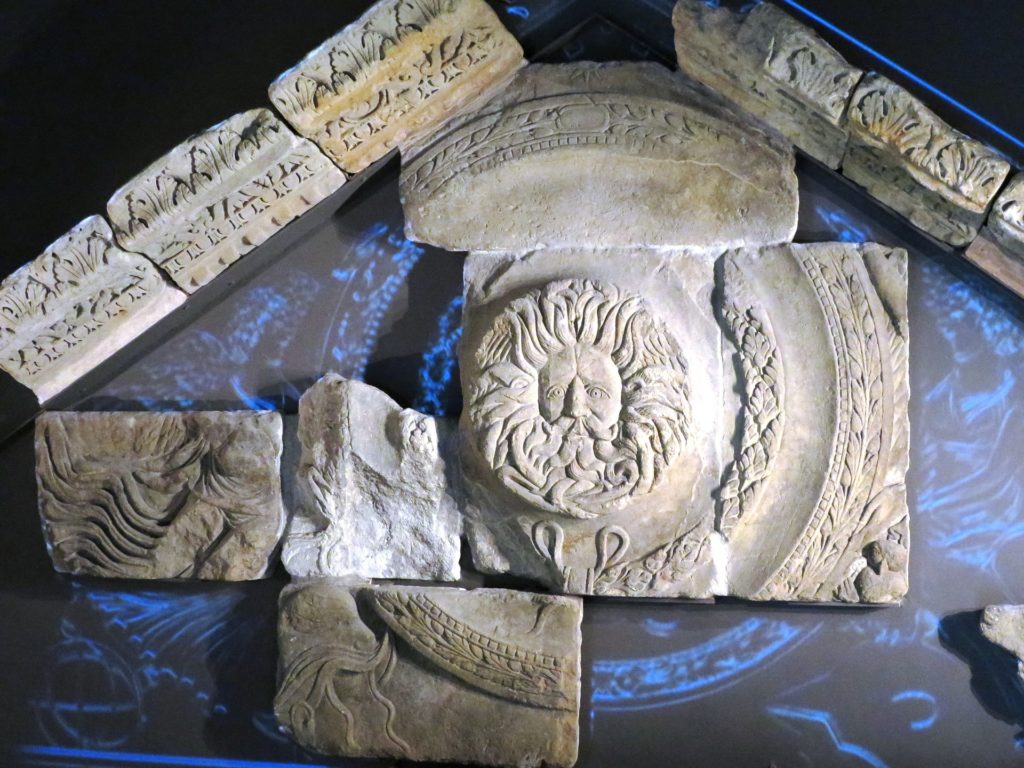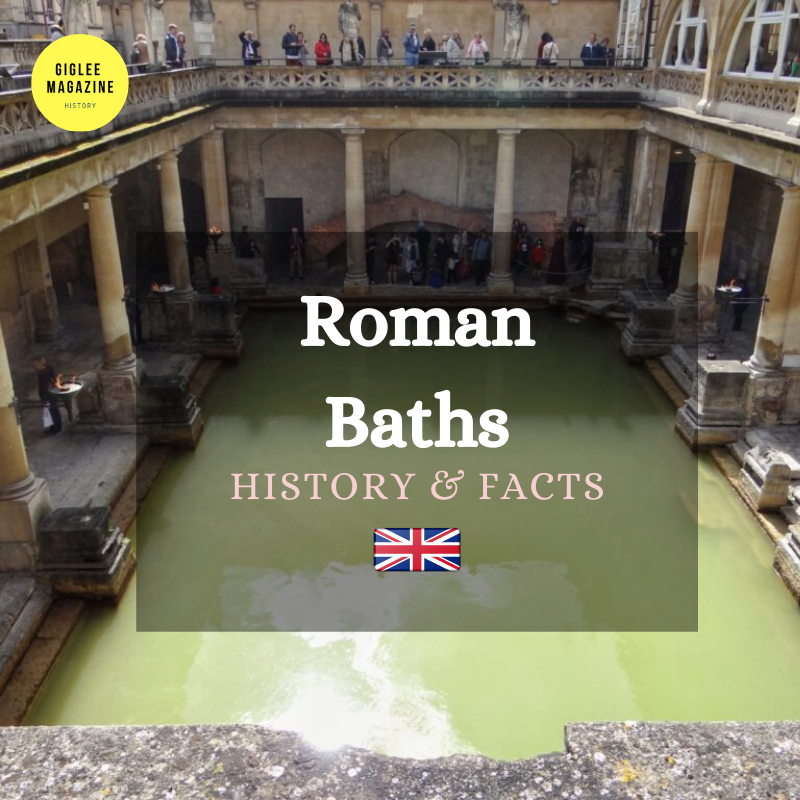
Roman Baths In Bath, England
Roman Baths: the Epitome of Luxury
These ancient Baths were more than just a place to get clean. Romans used them to relax and unwind
Watch the Videos
Part 1
Part 2
Listen to The Podcasts
Part 1
Part 2
Bath is a town located just a few miles from London. Stepping into this Georgian town is like walking into a Jane Austen novel and all the parties she would stage here.
However the strange name ‘Bath’ wasn’t a Georgian invention (1700s). The history of this town goes way back to the early centuries where reality and myth are but a smudged blur.
I had the chance of visiting Bath a few years ago. A short visit wouldn’t satisfy a curious mind. There’s much to explore in Bath especially its historic architecture.
Luckily, my trip did involve the Roman Baths. Now that I’ve read about them, I’ve come to admire these Baths much more.
What were the Roman Baths?
A few wealthy Romans had extensive baths in their own homes. These baths were big pools to soak yourself in warm water and relax.
Apart from these private ones, the public baths were a place for people to meet and spend some free time. You could compare them with movie theatres. Instead of watching a movie at home, you prefer to go to the theatres to meet your friends.
You’ll be surprised to know, people travelled far distances to visit these baths especially those at Bath. This Roman Bath was unique, huge and popular.
How did the Romans Use Their Baths?
Using a Roman Bath was a process. There were three baths: the Calidarium, the Tepidarium and the Frigidarium.
The first was a very hot bath at about 49 degrees celsius, the next called tepidarium was lukewarm and the last was a cold one.
Between these three baths, people could use changing rooms, dry heating rooms, sauna rooms and even massage rooms.
The Process of Enjoying a Roman Bath
The Romans would first change in the Apodyterium, a locker room.
They could then either exercise or sit in the Laconicum. The Laconicum was a unique feature which was a type of a Sauna with its special heating feature.
After the Sauna, slaves belonging to rich men would rub perfumed oils and scrape them using a strigil, a curved blade used as a scraper.
Following a relaxing massage, they’d step into the hot bath, then to the lukewarm one and finally into the cold bath.
The complexes would also include libraries, have entertainment programmes and other social programmes.
You could call a Roman Bath a community hub.
Imagine soaking yourself in one. Gosh I am already feeling relaxed!
The Roman Baths at Bath
You’ll be surprised to know, archeologists have not dug out the entire Roman Bath complex in Bath.
The Spring which Romans considered sacred along with the three baths it fills, is open for tourists.
There’s a labyrinth running under the city of Bath that’s still unexplored.
The entire complex is huge and archaeologists are digging up some more parts for school students to explore in a new Learning Centre.
Where does the Water come from?
The thermal spring at the Roman Baths has a history too. The water you see collected in the Bath is thousands of years old, even if it has just been spewed up from the Sacred Spring. By being thousands of years old, I mean this water hasn’t been touched by sunlight for a couple of thousand years.
The rainwater that seeps into the surface of the earth at a place called Mendips near Bath takes thousands of years to permeate past the rocks and journey to the centre of the earth. Right before touching the earth’s burning core, it takes a turn almost at boiling point of 90 degrees. This hot water splashes out as a thermal spring and into the various Baths. When it reaches the earth’s surface, its just around 46 degrees.
About 240,000 gallons of water gushes out from the Sacred Spring every single day!
Across these thousands of years, rainwater is converted into thermal water. This thermal water gushes out carrying iron and 40 other minerals from the earth’s core.
It is the wonder of nature.
The Infrastructure
The Romans were ingenious in building their baths.
In the 1st Century AD, they channeled the spring water into three pools and then constructed a drain that would carry the used water to the River Avon.
They lined all the drains with lead and have now turned orange due to the minerals in the spring water.
Roman Baths typically also had a hypocaust system. I think of this as another piece of intelligent heating infrastructure.
A hypocaust included a group of tunnels under the surface of the structure lined with terracotta bricks. These tunnels were connected to a chamber where a fire burned. The heat would then travel across the tunnels, heating up the terracotta bricks and the walls.
The floor of the structure above, would in turn heat, providing warmth to the room. In some cases a hypocaust system was also used to heat the water in the baths.
Since the Roman Baths in Bath had a natural hot thermal spring, they used the hypocaust for the sauna rooms. You’ll find an exposed hypocaust system here during your visit today.
Picture Curtesy: Joyofmuseums via Wikipedia Commons
What did the Roman Baths look like in their prime?
At the entrance, we know a huge Gorgon’s head welcomed every visitor. It wasn’t a real Gorgon but a depiction that made the pediment (triangular part at the entrance above a set of pillars). The Gorgon was evil. Goddess Minerva had slain this demon, according to legends. She wore the Gorgon’s head on her person.
Before entering the baths, the Romans probably prayed at the temple of Sulius Minerva. This complex was dedicated to this Goddess after which this complex was dedicated.
The temple is said to have had a tall larger than life statue of this Roman Goddess. This statue might have been the focus. Sunlight that entered through the door lit this statue. The rest of the walls enclosed the temple and shrouded it in darkness. The temple fire also provided light.
After prayers, you’d step into the baths.
The Great Bath was indeed magnificent. Huge Corinthian columns held the wooden roof. Newer columns were added when they replaced the wood with ceramic.
This Bath stood above the rest of the chamber. They had to climb four stairs to approach it.
It may have also held niches in the walls for bathers to sit in and enjoy
The Circular Bath probably had a fountain within itself. It would have been a sight to behold.
The Romans also left behind certain interesting artefacts.
Archeologists found a strange tin mask in the drains along with 34 gemstones.
Romans also used curse tablets, a sort of grievance letters sent to the Goddess herself. They complained about stolen clothes, and one even about a stolen wife! These tablets, as the name suggests also had some rather gruesome curses for the thief!
You must be now wondering, how did such a marvellous place even develop?
The Origins of the Bath
When the early Britons before the 1st Century AD came here, they might have been surprised to see the hot water that gushed out. It was the grace of God. They might have prayed here or probably bathed here, we don’t know much. Although we do know that they worshipped a Goddess called Sulis. She was worshipped as a healing water goddess. Her origins are again the source of mystery. She might have been a Celtic Goddess.
Whatever her origins, Sulis was influential and gave Bath its first name, Aquae Sulis.
When the Romans came to Bath in the 1st century, they discovered the springs and probably thought it a blessing from the Gods. The hot water spring would certainly have been a respite from the cold English weather.
The Romans quickly built a temple here, right next to the Spring. The temple was dedicated to the Goddess Sulis Minerva. Minerva was the Roman Goddess of wisdom and Sulis the ancient Goddess of this land.
Paterae were metal pans used by the Romans to make offerings to Sulis Minerva. They carried the letters DSM meaning Deae Sulis Minerva.
The Baths are Built
They added to this temple premises by constructing a major complex we recognise to be a Roman Bath. This complex had changing rooms, saunas, three types of different baths with water stored at different temperatures. It must have been a busy place.
This Roman site underwent major changes in the 2nd Century AD. They added in a few more chapels and had an ambulatory (a covered passage) constructed around the temple.
The hot water spring, which was considered to be the Sacred Spring was enclosed using barrel vaults. Enclosing the spring kept it in darkness. They had no intention for reducing evaporation. Water was abundant here.
Few statues and columns surrounded the spring. It must have been a place to sit and reminisce or pray, a very peaceful place.
The footfall continued till the 4th century. The temple and its bath must have been privy to many secrets, business deals, frustrations, complaints, emotions of hope and faith.
All these stories and its people were fast waning as Christianity began to grip England.
This Roman Temple and its elaborate yet luxurious baths were forgotten.
Picture Curtesy: suesun via Pixabay
Lost to Neglect
The walls crumbled and by the 6th or 7th century, the oak piles that covered the Sacred Spring came crashing down. These oak piles provided a good foundation for the spring though.
During the reign of King Henry I in the 12th century, the King’s Bath was built over the old Roman Spring. They had niches for bathers to sit in and relax.
By the 17th century, they added in a Master of the Baths chair to the southern side of the bath.
A statue of the mythical King Bladud overlooked this Bath. It was a legend that King Bladud had discovered the warm spring and founded the city of Bath.
In the 18th century, the thermal hot water spring was frequented for health reasons. Doctors considered it medicinal and encouraged patients to try it out.
Beau Nash then encroached a little into the King’s Bath to build the Pump Room in the 18th century to meet the sudden influx of visitors. This Pump Room has been transformed into a restaurant today, for visitors to sit and relax.
Rediscovery
Major Charles Davis, was responsible the work of inspecting the Kings Bath. In 1880, he was harried by a leak. He decided to dig into the problem and stumbled upon the lost Roman Baths. This rediscovery was huge for the town of Bath.
Especially since the Roman Bath complex is not what we see today. It runs under the city, its houses and roads! Much of it has not been completely excavated.
Such unexplored archeological sites are rather interesting to me.
Just imagine the people and tourists in Bath walking its streets and admiring its many attractions. And all along under their feet lies the very remains of a structure that gave this city its name.
My only regret is not spending enough time in Bath.
This town has a charm to itself owing to its well preserved medieval architecture. And as for its two thousand year old baths, the 1st century and the 18th century go hand in hand as if made from the same rock!
If ever in Bath, make sure you visit the Roman Baths and Bath Abbey which I am told is another marvel.
Is That Gold!
Did You Know: In 2007, archeologists excavated 17,577 Roman coins at the Gainsborough Hotel in Beau Street, Bath. These coins date back to the 32BC – 274AD and were hidden away in eight money bags fused together. The Heritage Lottery Fund purchased this treasure for a whooping £372,500!
Bibliography
The Story of the Roman Baths: Patricia Southern
The Official Website of Roman Baths
Baths and Bathing as an Ancient Roman
Roman Baths
Sulis, Celtic Sun Goddess of Healing and Prophecy by Judith Shaw
The Excavation of Roman Baths at Bath: Charles E. Davis
Would You Like to Read More? Please sign up for the weekly update
Read More about heritage monuments in England:
Fascinating Facts About Stonehenge
The Birthplace of William Shakespeare
DISCLAIMER: The intention of this article is not to hurt anyone's sentiments. The thoughts expressed in the article are purely those stated by the author of the work. The information provided on this website may not be complete, reliable, accurate and/or updated. The details you share with the website will not be shared or sold. We are not liable if in case of theft, your data is stolen. The content on this website is provided without any warranties whether express or implied. If you have a doubt, query or complaint please write to editor@giglee.in and we shall respond as soon as possible.




